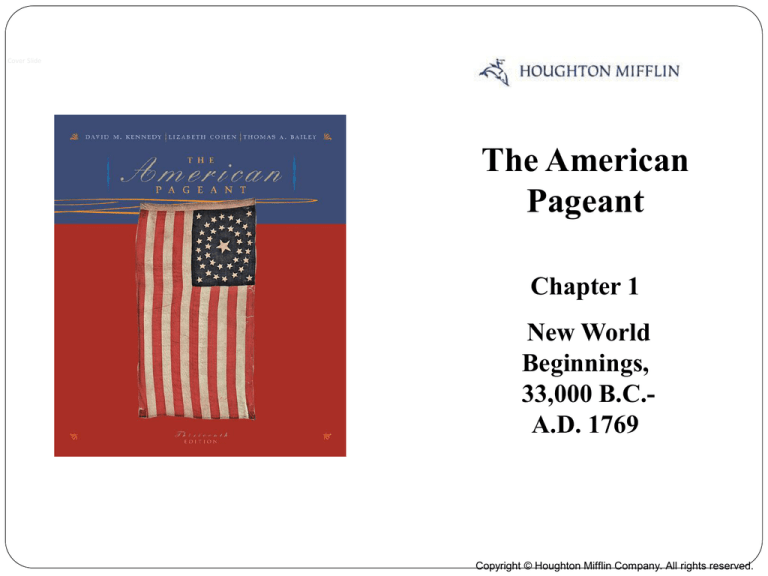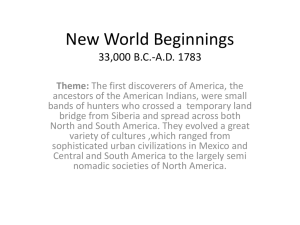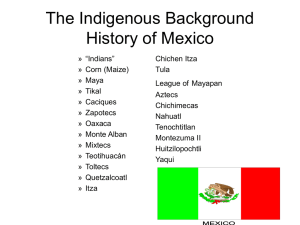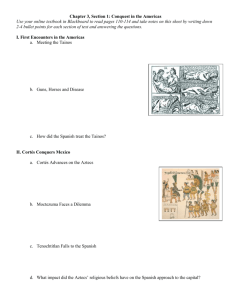
Cover Slide
The American
Pageant
Chapter 1
New World
Beginnings,
33,000 B.C.A.D. 1769
Copyright © Houghton Mifflin Company. All rights reserved.
The Shaping of North America
Recorded history - 6,000 years ago
500 years ago - Europeans set foot on the Americas to
begin colonization
Theory of Pangaea - suggests that the continents were
once nestled together into one mega-continent
Spread out as drifting islands
Geologic forces of continental plates created
Appalachian and Rocky Mountains
The Great Ice Age thrust down over North America &
scoured the present day American Midwest
Peopling the Americas
The Land Bridge theory
Great Ice Age diminished - the glaciers over North America diminished
Theory holds a Land Bridge emerged linking Asia & North America
across what is now known as the Bering Sea
people walked across the "bridge" before the sea level rose and sealed it off;
thus populating the Americas.
The Land Bridge - occurred an estimated 35,000 years ago
Many peoples
Those groups that traversed the bridge spread across North, Central, and South
America
Countless tribes emerged with an estimated 2,000 languages
Incas: Peru, with elaborate network of roads and bridges linking their empire
Mayas: Yucatan Peninsula, with their step pyramids
Aztecs: Mexico, with step pyramids and huge sacrifices of conquered peoples
The Earliest Americans
Development of corn or maize - 5,000 B.C. in Mexico
revolutionary in that:
people didn't have to be hunter-gatherers, they could settle down and be
farmers
gave rise to towns and then cities
Corn arrived in the present day U.S. around 1,200 B.C
Pueblo Indians
1st American corn growers
lived in adobe houses (dried mud) and pueblos ("villages" in Spanish)
Pueblos are villages of cubicle shaped adobe houses, stacked one on top the
other and often beneath cliffs
elaborate irrigation systems to draw water away from rivers to grown corn
Mound Builders
built huge ceremonial and burial mounds and were located in the Ohio Valley
Cahokia, near East St. Louis today, held 40,000 people
The Earliest Americans, Con’t.
Eastern Indians
grew corn, beans, and squash in three sister farming:
corn grew in a stalk providing a trellis for beans, beans grew up the stalk, squash's
broad leaves kept the sun off the ground and thus kept the moisture in the soil
had the best (most diverse) diet of all North American Indians and is typified by
the Cherokee, Creek, Choctaw (South) and Iroquois (North).
Iroquois Confederation
Hiawatha - legendary leader of the group
group of 5 tribes in New York state
matrilineal as authority and possessions passed down through the female line
each tribe kept their independence
met occasionally to discuss matters of common interest, like war/defense
not the norm
usually, Indians were scattered and separated (and thus weak)
The Earliest Americans, Con’t.
Native Americans
felt no man owned the land,
the tribe did
felt nature was mixed with
many spirits
felt nature was sacred
had little or no concept or
interest in money
Europeans
private property
Christian and monotheistic
felt nature and land was given
to man by God in Genesis to
be subdued and put to use
loved money or gold
Indirect Discoverers of the New World
1st Europeans to come to America were the Norse (Vikings from
Norway)
around 1000 AD -Vikings landed - led by Erik the Red and Leif
Erikson
landed in Newfoundland or Vinland (because of all the vines)
these men left America and left no written record and therefore
didn't get the credit
only record is found in Viking sagas or songs
Christian Crusaders of Middle Ages fought in Palestine to regain
the Holy Land from Muslims
mixing of East and West created a sweet-tooth where
Europeans wanted the spices of the exotic East
Europeans Enter Africa
Marco Polo traveled to China and stirred up a storm of European interest
Mixed with desire for spices, an East to West (Asia to Europe) trade flourished - had to be overland
initiated new exploration down around Africa in hopes of an easier (all water) route
Portugal started a sailing school to find better ways to get to the Spice Islands, rounding Africa's
southern Cape of Good Hope
New developments:
caravel: a ship with triangular sail that could better tack (zig-zag) ahead into the wind and thus
return to Europe from Africa coast
compass: to determine direction
astrolabe: a sextant gizmo that could tell a ship's latitude
Slave trade begins
1st slave trade was across the Sahara Desert
Later - along the West African coast
slave traders purposely busted up tribes and families in order to squelch any possible
uprising
Slaves wound up on sugar plantations the Portuguese had set up on the tropical islands off
Africa's coast
Spain watched Portugal's success with exploration and slaving and wanted a piece of the pie
Columbus Comes upon a New World
Christopher Columbus convinced Isabella and Ferdinand to fund his
expedition
Goal - to reach the East (East Indies) by sailing west, bypassing the
around-Africa route that Portugal monopolized
Misjudged the size of the Earth, thinking it 1/3 the size of what it was
After 30 days or so at sea, he struck land, he assumed he'd made it to
the East Indies and therefore mistook the people as "Indians"
Spawned the following system:
Europe would provide the market, capital, technology
Africa would provide the labor
The New World would provide the raw materials (gold, soil, lumber)
When Worlds Collide
Huge importance - biological flip-flop of Old and New Worlds
we traded life such as plants, foods, animals, germs
Columbian Exchange:
From the New World (America) to the Old
corn, potatoes, tobacco, beans, peppers, manioc, pumpkin, squash,
tomato, wild rice, etc
also, syphilis
From the Old World to the New
cows, pigs, horses, wheat, sugar cane, apples, cabbage, citrus, carrots,
Kentucky bluegrass, etc
devastating diseases (smallpox, yellow fever, malaria), as Indians had no
immunities
The Indians had no immunities in their systems built up over
generations
An estimated 90% of all pre-Columbus Indians died, mostly due to
disease
The Spanish Conquistadores
Treaty Line of Tordesillas 1494: Portugal and Spain feuded over who got what land
Pope drew this line as he was respected by both
line ran North-South, and chopped off the Brazilian coast of South America
Portugal got everything east of the line (Brazil and land around/under Africa)
Spain got everything west of the line (which turned out to be much more, though they didn't know it at the
time)
Conquistadores = "conquerors"
Vasco Balboa: "discovered"the Pacific Ocean across isthmus of Panama
Ferdinand Magellan: circumnavigates the globe (1st to do so)
Ponce de Leon: touches and names Florida looking for legendary Fountain of Youth
Hernando Cortes: enters Florida, travels up into present day Southeastern U.S., dies and is "buried"in
Mississippi River
Francisco Pizarro: conquers Incan Empire of Peru and begins shipping tons of gold/silver back to Spain
huge influx of precious metals made European prices skyrocket (inflation)
Francisco Coronado: ventured into current Southwest U.S. looking for legendary El Dorado, city of gold, found
the Pueblo Indians
Encomienda system established
Indians were "commended"or given to Spanish landlords
The idea (encomienda) - Indians would work and be converted to Christianity
basically just slavery on a sugar plantation guised as missionary work
The Conquest of Mexico
Hernando Cortez conquered the Aztecs at Tenochtitlan
Cortez went from Cuba to present day Vera Cruz, then marched over
mountains to the Aztec capital
Montezuma, Aztec king, thought Cortez might be the god Quetzalcoatl who
was due to re-appear the very year
Montezuma welcomed Cortez into Tenochtitlan
The Spanish lust for gold led Montezuma to attack on the noche triste, sad
night
Cortez and men fought their way out, but it was smallpox that eventually
beat the Indians
The Spanish then destroyed Tenochtitlan, building the Spanish capital (Mexico
City) exactly on top of the Aztec city
A new race of people emerged, mestizos, a mix of Spanish and Indian blood
The Spread of Spanish America
Spanish society quickly spread through Peru and Mexico
A threat came from neighbors:
English: John Cabot (an Italian who sailed for England) touched the coast of
the current day U.S.
France: Giovanni de Verrazano also touched on the North American
seaboard.
France: Jacques Cartier went into mouth of St. Lawrence River (Canada).
To oppose this, Spain set up forts (presidios) all over the California coast. Also
cities, like St. Augustine in Florida.
Don Juan de Onate followed Coronado's old path into present day New
Mexico. He conquered the Indians ruthlessly, maiming them by cutting off one
foot of survivors just so they'd remember.
Santa Fe- 1610
Catholic mission established
Pope’s Rebellion in 1680- destroyed Catholic church and
killed priests and settlers
-Took nearly 50 years for the Spanish to retake it.
-Refugees will establish San Antonio….the alamo.
The Spread of Spanish America, con’t.
Despite mission efforts, the Pueblo Indians revolted in Pope's
Rebellion
Robert de LaSalle sailed down the Mississippi River for France
claiming the whole region for their King Louis and naming the
area "Louisiana" after his king
started a slew of place-names for that area, from LaSalle,
Illinois to "Louisville" and then on down to New Orleans (the
American counter of Joan of Arc's famous victory at Orleans)
Black Legend: the notion that Spaniards only brought bad things
(murder, disease, slavery); though true, they also brought good
things such as law systems, architecture, Christianity, language,
civilization
Black Legend is partly, but not entirely, accurate
CHAPTER THEMES
Theme: The first discoverers of America, the ancestors of the American Indians, were
small bands of hunters who crossed a temporary land bridge from Siberia and spread
across both North and South America. They evolved a great variety of cultures, which
ranged from the sophisticated urban civilizations in Mexico and Central and South
America to the largely seminomadic societies of North America.
Theme: Europe's growing demand for Eastern luxuries prompted exploration in the
hopes of reducing the expense of those goods with new trade routes. Exploration
occurred incrementally, beginning with the Portuguese moving around the coast of
Africa and establishing trading posts. Awareness of the New World and its wealth
pushed exploration across the Atlantic. Spanish exploration continued in the same
fashion, first in the Caribbean islands then expanding into South and North America.
Theme: Portuguese and Spanish explorers encountered and then conquered much of
the Americas and their Indian inhabitants. This “collision of worlds” deeply affected all
the Atlantic societies—Europe, the Americas, and Africa—as the effects of disease,
conquest, slavery, and intermarriage began to create a truly “new world” in Latin
America, including the borderlands of Florida, New Mexico, and California, all of which
later became part of the United States.
Christopher Columbus
(1451–1506)
Although his encounter with continents and peoples previously unknown to Europeans transformed
world history, Columbus, the Genoese sailor who discovered America for the Spanish monarchy, never
really understood the nature or significance of his accomplishment.
Having sailed under the flags of many nations, including Portugal, Columbus was already a well-known,
successful voyager when he became obsessed with the idea of reaching Cathay (China) and the Indies by
sailing west. His frustrating inability to gain backing for the venture ended when Ferdinand and Isabella
agreed to supply him with three ships.
The great achievement of Columbus’s first voyage was not only to navigate unknown waters under
unprecedented conditions but to keep his crews from mutiny—especially when the ships were
becalmed after nearly sixty days. Although well aware during all his voyages that he was not in China or
India, Columbus became firmly convinced that he had found islands just off the Asian coast and that the
rich cities of Japan and China were not far away. This notion was reinforced by his desperate need to
obtain continuing funding from the Spanish rulers, who pressed ever harder for concrete economic gains
from the voyages.
Quote: “The inhabitants of this and of all the other islands I have found or gained intelligence of, both
men and women, go as naked as they were born, with the exception that some of the women cover one
part only with a single leaf or grass with a piece of cotton, made for that purpose…. I gave away a
thousand good and pretty articles which I had brought with me in order to win their affection, and that
they might be led to become Christians, and be well inclined to love and serve their highnesses and the
whole Spanish nation….” (Letter on the first voyage, 1493)
REFERENCE: John Stewart Wilford, The Mysterious History of Columbus (1991).
Moctezuma II
(1466–1520)
Moctezuma II (also called Montezuma II) was the Aztec ruler who succumbed to Cortés’s invasion of
Mexico.
He was the tenth in the line of Aztec emperors who controlled the vast regions and diverse peoples of
Mexico from their rich capital at Tenochtitlán. Like other members of the royal aristocracy, he lived in
luxury and served as a high priest of the elaborate but cruel Aztec religion. He succeeded to the throne
in 1502 on the death of his uncle Ahuitzotl.
Before Cortés arrived, Moctezuma had expanded the Aztec realm, yet controlling the increasingly
restless subordinate peoples of the empire demanded more and more of his energy. He was particularly
devoted to the god Huitzilpochtli, but also came under the influence of astrologers and readers of
portents. Their pessimistic predictions about his fate evidently weakened his will to resist the Spanish
invaders.
After Cortés and his men seized Moctezuma and held him under house arrest, the people of
Tenochtitlán became increasingly hostile to their leader. When Moctezuma appeared in public for the
first time in nearly a year in early 1520, the angry populace showered him with stones before he could
retreat indoors. The Spanish claimed that the wounded ruler died shortly thereafter from the stoning,
but many Aztecs believed that the Spanish killed him. The truth remains unknown.
Quote: “I have in truth seen you and have now set eyes upon your force. You have come between mists
and clouds, and now it has come to pass. Now you have arrived, with much fatigue and toil. Come to our
land, come and repose.” (Message to Cortés as he approached Tenochtitlán, 1519)
REFERENCE: Hugh Thomas, Conquest: Montezuma, Cortes, and the Fall of Old Mexico (1994).
Hernán Cortés
(1485–1547)
Like many conquistadores, Cortés was born into a noble family but as a younger son failed to inherit extensive
lands and wealth. As a youth, he was restless, ambitious, and nearly uncontrollable. In 1504, at age nineteen,
he sailed for the island of Hispaniola (today’s Dominican Republic and Haiti), at that time the headquarters of
Spanish activity in the New World.
Cortés farmed and worked as a minor town official for six years, but he longed for greater adventures. In 1511,
he joined a successful expedition to Cuba and then used a commission from the governor of Cuba, Velazquez,
to assemble an expedition of eleven ships, five hundred soldiers, and sixteen horses. Although Velazquez soon
changed his mind, Cortés had already sailed for Mexico. Cortés’s brilliant, if treacherous, combination of
military, political, and psychological tactics overcame Aztec resistance and gained him an empire larger than
Spain. His reports of his conquests, contained in five lengthy letters to King Charles V of Spain, are full of
fascinating detail, as well as much boasting and exaggeration.
Cortés was a talented administrator, but peaceful pursuits did not suit him, and in 1524 he headed for
Honduras in search of further glory. There, he succeeded only in ruining his health and undermining his position
in Mexico City. He retired to his estate in Cuernavaca, Mexico, in 1528, and in 1540 returned to Spain to die, a
broken man.
Quote: “Touching Montezuma’s palace and all that was remarkable in his magnificence and power, there is so
much to describe that I do not know how to begin.…There could be nothing more magnificent than that this
barbarian lord should have all the things of heaven to be found under his domain, fashioned in gold and silver
and jewels and feathers.” (Second letter to King Charles V, 1521)
REFERENCE: Jon White, Cortés and the Downfall of the Aztec Empire: A Study in the Conflict of Cultures, rev. ed.
(1989).
CHAPTER SUMMARY
Millions of years ago, the two American continents became geologically separated from the
Eastern Hemisphere land masses where humanity originated. The first people to enter these
continents came across a temporary land bridge from Siberia about 35,000 years ago. Spreading
across the two continents, they developed a great variety of societies based largely on corn
agriculture and hunting. In North America, some ancient Indian peoples like the Pueblos, the
Anasazi, and the Mississippian culture developed elaborate settlements. But on the whole, North
American Indian societies were less numerous and urbanized than those in Central and South
America, though equally diverse in culture and social organization.
The impetus for European exploration came from the desire for new trade routes to the East, the
spirit and technological discoveries of the Renaissance, and the power of the new European
national monarchies. The European encounters with America and Africa, beginning with the
Portuguese and Spanish explorers, convulsed the entire world. Biological change, disease,
population loss, conquest, African slavery, cultural change, and economic expansion were just
some of the consequences of the commingling of the Old World and the New World.
After they conquered and then intermarried with Indians of the great civilizations of South
America and Mexico, the Spanish conquistadores expanded northward into the northern border
territories of Florida, New Mexico, and California. There they established small but permanent
settlements in competition with the French and English explorers who also were venturing into
North America.
QUESTIONS FOR CLASS DISCUSSION
1.
How did Indian societies of South and North America differ from European societies at the time the two came
into contact? In what ways did Indians retain a “world view” different from that of the Europeans?
2.
What role did disease and forced labor (including slavery) play in the early settlement of America? Is the view of
the Spanish and Portuguese as especially harsh conquerors and exploiters valid—or is this image just another
version of the English “black legend” concerning the Spanish role in the Americas?
3.
Are the differences between Latin America and North America due primarily to the differences between the
respective Indian societies that existed in the two places, or to the disparity between Spanish and English culture?
What would have happened if the English had conquered densely settled Mexico and Peru, and the Spanish had
settled more thinly populated North America?
4.
In what ways are the early (pre-1600) histories of Mexican and the present-day American Southwest understood
differently now that the United States is being so substantially affected by Mexican and Latin American
immigration and culture? To what extent should this now be regarded as part of our American history?
5.
Why was the Old World able to dominate the New World? What were the strengths and weaknesses of the Old
World? What were the strengths and weaknesses of the New World?
6.
Should the Spanish conquistadores be especially blamed for the cruelties and deaths (including those by disease)
inflicted on the original Indian populations of the Americas? Is it possible to make such criticisms without falling
into the traditional English fallacies of the “black legend”?
7.
What is the long-term significance for Latin America of the “immortality” achieved by the conquistadores through
intermarriage with Indian women?




